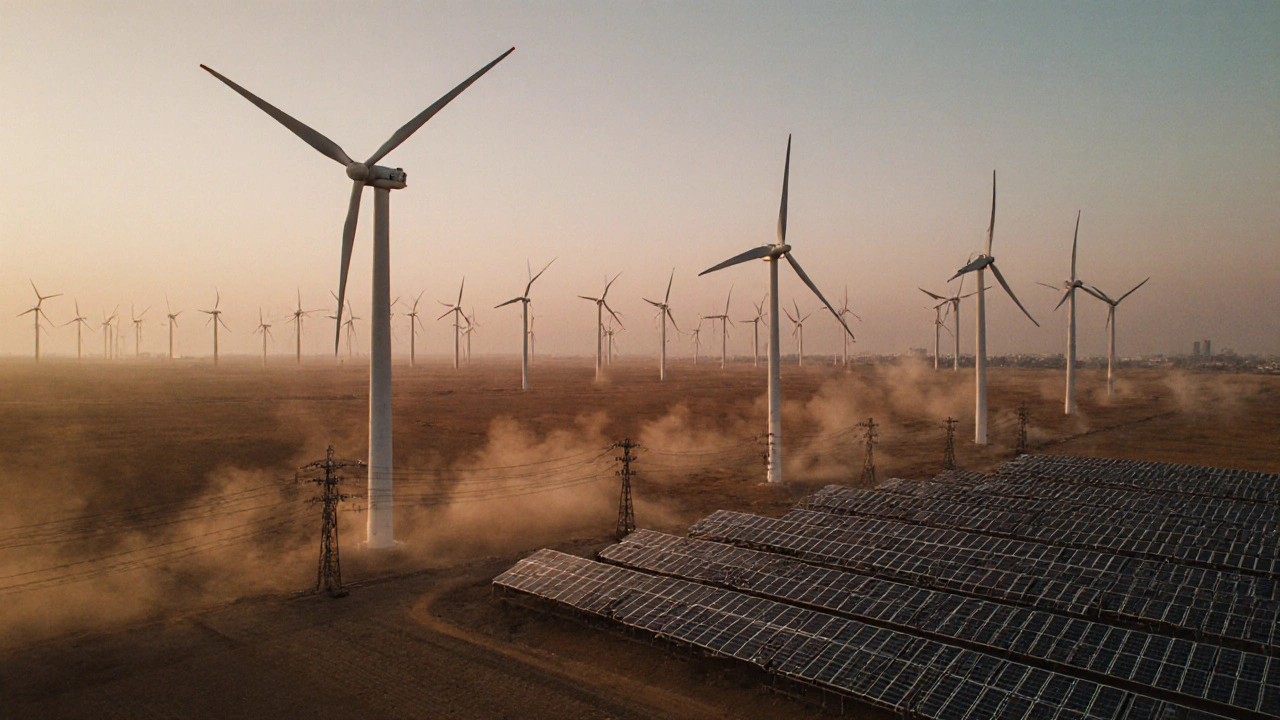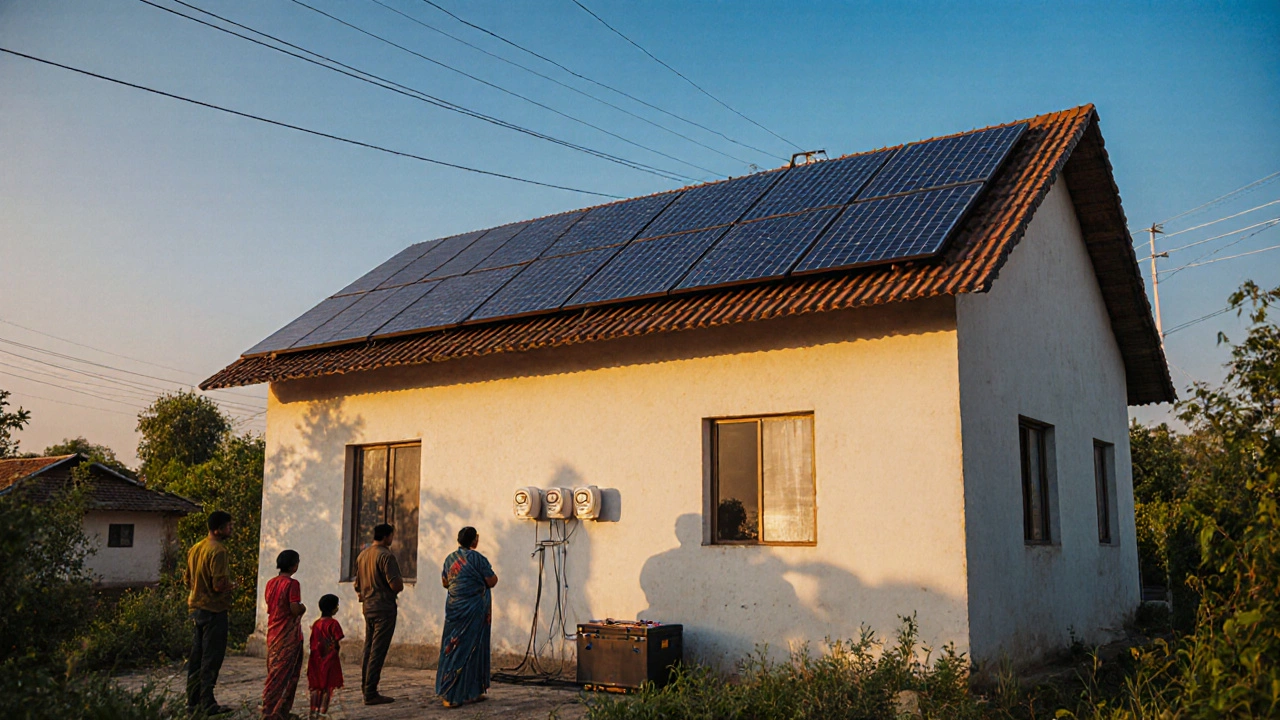Renewable Energy Cost Calculator
Calculate how much you could save by switching to renewable energy in India. Based on 2025 cost data from the article.
Your Electricity Usage
Five years ago, people still asked if switching to solar or wind meant paying more. Today, that question doesn’t just sound outdated-it’s wrong. In most parts of the world, including India, renewable energy isn’t just cleaner. It’s cheaper. And the gap keeps growing.
How much does solar cost today?
In 2025, the average cost to install rooftop solar in India is around ₹55,000 per kW. That’s down from ₹1.2 lakh in 2018. A typical 5 kW home system now costs about ₹2.75 lakh before subsidies. After the government’s 40% subsidy under the PM-KUSUM scheme, you’re looking at under ₹1.65 lakh out-of-pocket. That’s less than the price of a mid-range car.
And here’s what matters more: the cost per unit of electricity. Solar now generates power at ₹2.50 to ₹3.50 per kWh across most Indian states. Compare that to grid electricity from coal, which averages ₹6 to ₹8 per kWh in urban areas. Even with transmission losses and peak-time surcharges, solar wins by a wide margin.
Wind energy? Even cheaper in some places
In Rajasthan, Gujarat, and Tamil Nadu, onshore wind farms are producing electricity at ₹2.20 per kWh. That’s the lowest price for any large-scale power source in India. In fact, in 2024, a wind auction in Rajasthan hit ₹1.99 per kWh-lower than the operating cost of many old coal plants. Companies like Adani Green and ReNew are building gigawatt-scale wind projects because they make financial sense, not because they’re trendy.
Wind turbines last 25 years. Once built, the fuel-wind-is free. No mining. No trucking. No price spikes from global markets. That’s why utility-scale wind is now the cheapest source of new power in over 70 countries, including India.
Why fossil fuels aren’t really cheaper
Coal might look cheap at first glance. You see a ₹4,000-per-tonne price tag and think, "That’s affordable." But that’s only part of the story. Coal plants need constant maintenance. They burn out boilers. They clog filters. They need water for cooling-millions of liters daily. In drought-prone states like Maharashtra and Telangana, water shortages shut down coal plants for weeks. That’s not a glitch. It’s a design flaw.
Then there’s the hidden cost. Air pollution from coal causes 1.2 million premature deaths in India every year, according to the Health Effects Institute. The economic cost? Over ₹10 lakh crore annually in healthcare and lost productivity. That’s not on your electricity bill. But it’s still paid by you-through taxes, insurance, and sick days.
Imported gas? Even worse. When global gas prices spiked in 2022, India’s gas-fired power plants saw their costs jump 200%. Solar and wind? No change. Zero exposure. That’s stability you can’t buy.

Storage isn’t killing the savings anymore
People used to say, "Solar doesn’t work at night." True. But now, battery prices have dropped 80% since 2015. A 5 kWh home battery system costs ₹1.1 lakh today-down from ₹5.5 lakh five years ago. That’s enough to power lights, fans, and a fridge through the evening.
And utilities aren’t waiting. In Karnataka, the state grid now runs on 40% renewable energy during peak daylight hours. Batteries store the excess. Then they release it in the evening. The result? Power bills for homes and small businesses dropped 18% in 2024. That’s not theory. That’s real data from the Karnataka Electricity Regulatory Commission.
What about manufacturing and materials?
Yes, making solar panels and wind turbines needs metals, glass, and rare earths. But recycling is scaling fast. India’s first solar panel recycling plant opened in Bengaluru in 2023. It can process 10,000 tons a year. By 2027, over 90% of a solar panel’s materials can be recovered and reused.
And here’s the kicker: renewable energy creates more jobs per megawatt than coal. For every 1 MW of solar, you get 5-8 jobs in installation, maintenance, and logistics. Coal? Just 1-2. In Gujarat, over 120,000 people now work in solar and wind. Most of them didn’t have formal engineering degrees. They learned on the job. That’s real economic power.

Who wins when you switch?
Homeowners? Lower bills. Small businesses? More predictable costs. Farmers? Income from leasing land for solar panels. Cities? Less smog, fewer hospital visits. The government? Less subsidy burden on fuel imports. In 2024, India saved ₹1.8 lakh crore by avoiding coal imports thanks to renewable growth.
Even the banks are betting on it. In 2025, 70% of new power project loans in India went to solar and wind. Not coal. Not gas. Renewables. That’s not charity. That’s risk management.
Is it cheaper everywhere?
Almost. In remote villages without grid access, solar microgrids are now cheaper than diesel generators. A 10 kW solar microgrid with storage costs ₹6 lakh. A diesel generator running 12 hours a day? ₹8.5 lakh per year in fuel alone.
The only places where renewables still struggle are in regions with terrible policy. Where net metering is delayed. Where subsidies are delayed. Where distribution companies refuse to buy excess power. That’s not a technical problem. It’s a bureaucratic one.
What’s next?
By 2030, India plans to have 500 GW of renewable capacity. That’s half the country’s total power needs. Solar and wind will be the cheapest sources-by far. And as battery tech improves and green hydrogen scales, even heavy industries like steel and cement will switch.
The question isn’t "Is renewable energy cheaper?" anymore. It’s "Why are you still paying more?"
Is solar power cheaper than electricity from the grid in India?
Yes, in most cases. The average cost of solar power in India is ₹2.50-₹3.50 per kWh, while grid electricity from coal costs ₹6-₹8 per kWh. After subsidies, rooftop solar systems pay for themselves in 4-5 years and then generate free power for 20+ years.
Are wind turbines more cost-effective than solar panels?
In windy regions like Rajasthan and Gujarat, wind energy is cheaper-around ₹2.20 per kWh. Solar is slightly more expensive but works better in urban rooftops and areas with less wind. For most homes, solar is the practical choice. For large farms or open land, wind often wins on cost.
Do I need batteries to make solar worth it?
Not always. If your grid is reliable, you can send excess solar power back and get credits (net metering). But if you face frequent outages or live off-grid, batteries are worth it. A 5 kWh battery now costs under ₹1.1 lakh and can cover evening essentials like lights, fans, and a fridge.
Why are coal plants still running if renewables are cheaper?
Many coal plants were built years ago with borrowed money. Shutting them down early means losing that investment. Also, some state utilities still have contracts with coal suppliers. But new power projects? Almost all are solar or wind. The market has moved. The old plants are just holding on.
Can renewable energy power industries like steel and cement?
Yes, and it already is. Companies like Tata Steel and JSW are testing green hydrogen made from solar power to replace coal in furnaces. In 2025, India’s first solar-powered cement plant began operations in Rajasthan. It cuts emissions by 70% and saves ₹200 crore a year in fuel costs.
What’s the biggest barrier to switching to renewables?
Not cost. It’s bureaucracy. Delays in net metering approvals, slow subsidy disbursements, and utilities refusing to buy excess power are the real hurdles. The technology is ready. The money is there. What’s missing is consistent policy execution.
How long do solar panels last?
Most solar panels come with a 25-year performance warranty. They don’t stop working after that-they just produce less. After 25 years, they still generate 80-85% of their original output. Many last 30-40 years. Inverters need replacing every 10-12 years, but that’s a small cost compared to ongoing fuel bills.
Is renewable energy reliable during monsoons or cloudy days?
Yes, because the grid is now a mix of sources. Wind often picks up during monsoons. Batteries store daytime solar for use when clouds roll in. And when all else fails, hydropower and geothermal provide backup. India’s grid is no longer dependent on one source. It’s smarter, more flexible, and more resilient.



